Epidemiology cornerstone of public health Assignment
VerifiedAdded on 2021/02/19
|11
|3016
|126
AI Summary
Contribute Materials
Your contribution can guide someone’s learning journey. Share your
documents today.
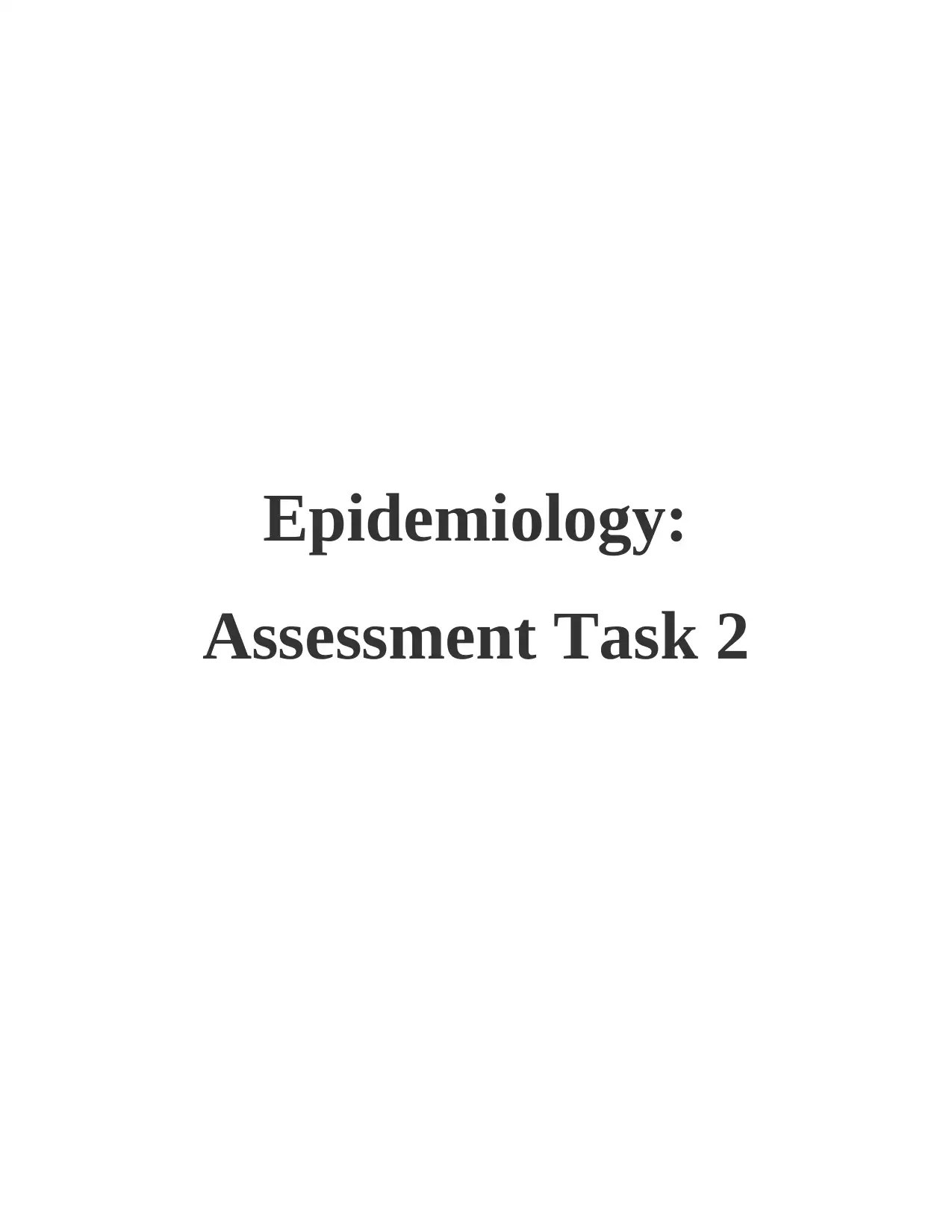
Epidemiology:
Assessment Task 2
Assessment Task 2
Secure Best Marks with AI Grader
Need help grading? Try our AI Grader for instant feedback on your assignments.
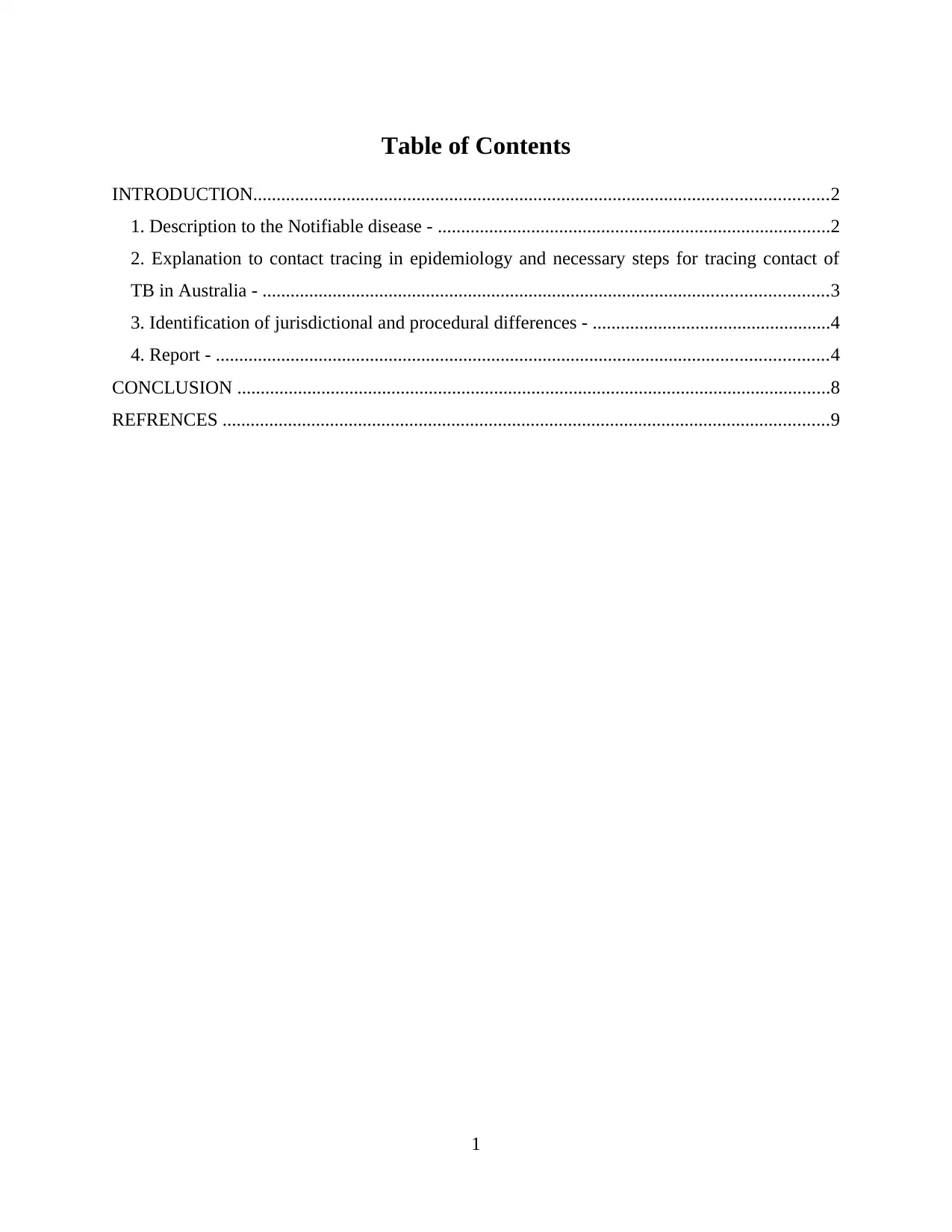
Table of Contents
INTRODUCTION...........................................................................................................................2
1. Description to the Notifiable disease - ....................................................................................2
2. Explanation to contact tracing in epidemiology and necessary steps for tracing contact of
TB in Australia - .........................................................................................................................3
3. Identification of jurisdictional and procedural differences - ...................................................4
4. Report - ...................................................................................................................................4
CONCLUSION ...............................................................................................................................8
REFRENCES ..................................................................................................................................9
1
INTRODUCTION...........................................................................................................................2
1. Description to the Notifiable disease - ....................................................................................2
2. Explanation to contact tracing in epidemiology and necessary steps for tracing contact of
TB in Australia - .........................................................................................................................3
3. Identification of jurisdictional and procedural differences - ...................................................4
4. Report - ...................................................................................................................................4
CONCLUSION ...............................................................................................................................8
REFRENCES ..................................................................................................................................9
1
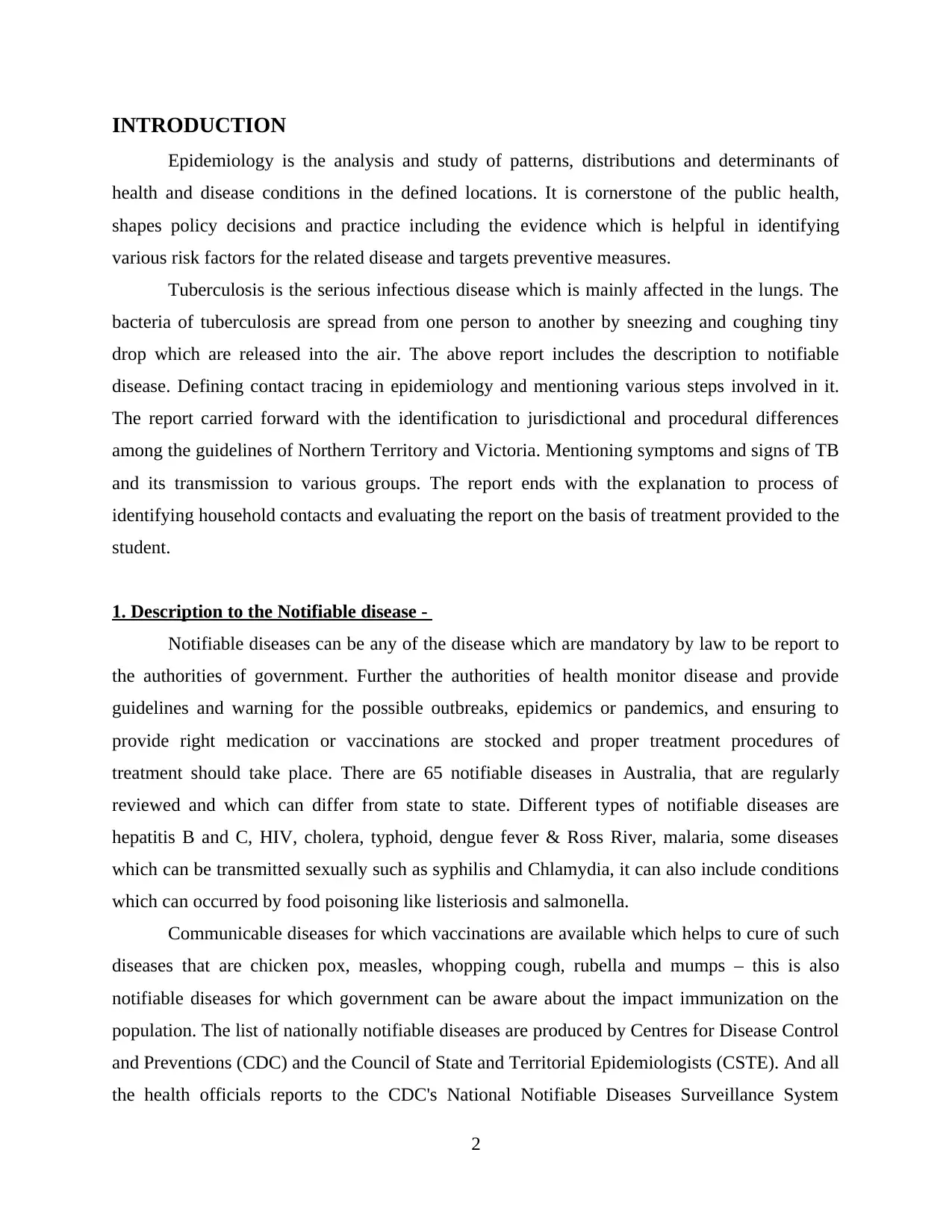
INTRODUCTION
Epidemiology is the analysis and study of patterns, distributions and determinants of
health and disease conditions in the defined locations. It is cornerstone of the public health,
shapes policy decisions and practice including the evidence which is helpful in identifying
various risk factors for the related disease and targets preventive measures.
Tuberculosis is the serious infectious disease which is mainly affected in the lungs. The
bacteria of tuberculosis are spread from one person to another by sneezing and coughing tiny
drop which are released into the air. The above report includes the description to notifiable
disease. Defining contact tracing in epidemiology and mentioning various steps involved in it.
The report carried forward with the identification to jurisdictional and procedural differences
among the guidelines of Northern Territory and Victoria. Mentioning symptoms and signs of TB
and its transmission to various groups. The report ends with the explanation to process of
identifying household contacts and evaluating the report on the basis of treatment provided to the
student.
1. Description to the Notifiable disease -
Notifiable diseases can be any of the disease which are mandatory by law to be report to
the authorities of government. Further the authorities of health monitor disease and provide
guidelines and warning for the possible outbreaks, epidemics or pandemics, and ensuring to
provide right medication or vaccinations are stocked and proper treatment procedures of
treatment should take place. There are 65 notifiable diseases in Australia, that are regularly
reviewed and which can differ from state to state. Different types of notifiable diseases are
hepatitis B and C, HIV, cholera, typhoid, dengue fever & Ross River, malaria, some diseases
which can be transmitted sexually such as syphilis and Chlamydia, it can also include conditions
which can occurred by food poisoning like listeriosis and salmonella.
Communicable diseases for which vaccinations are available which helps to cure of such
diseases that are chicken pox, measles, whopping cough, rubella and mumps – this is also
notifiable diseases for which government can be aware about the impact immunization on the
population. The list of nationally notifiable diseases are produced by Centres for Disease Control
and Preventions (CDC) and the Council of State and Territorial Epidemiologists (CSTE). And all
the health officials reports to the CDC's National Notifiable Diseases Surveillance System
2
Epidemiology is the analysis and study of patterns, distributions and determinants of
health and disease conditions in the defined locations. It is cornerstone of the public health,
shapes policy decisions and practice including the evidence which is helpful in identifying
various risk factors for the related disease and targets preventive measures.
Tuberculosis is the serious infectious disease which is mainly affected in the lungs. The
bacteria of tuberculosis are spread from one person to another by sneezing and coughing tiny
drop which are released into the air. The above report includes the description to notifiable
disease. Defining contact tracing in epidemiology and mentioning various steps involved in it.
The report carried forward with the identification to jurisdictional and procedural differences
among the guidelines of Northern Territory and Victoria. Mentioning symptoms and signs of TB
and its transmission to various groups. The report ends with the explanation to process of
identifying household contacts and evaluating the report on the basis of treatment provided to the
student.
1. Description to the Notifiable disease -
Notifiable diseases can be any of the disease which are mandatory by law to be report to
the authorities of government. Further the authorities of health monitor disease and provide
guidelines and warning for the possible outbreaks, epidemics or pandemics, and ensuring to
provide right medication or vaccinations are stocked and proper treatment procedures of
treatment should take place. There are 65 notifiable diseases in Australia, that are regularly
reviewed and which can differ from state to state. Different types of notifiable diseases are
hepatitis B and C, HIV, cholera, typhoid, dengue fever & Ross River, malaria, some diseases
which can be transmitted sexually such as syphilis and Chlamydia, it can also include conditions
which can occurred by food poisoning like listeriosis and salmonella.
Communicable diseases for which vaccinations are available which helps to cure of such
diseases that are chicken pox, measles, whopping cough, rubella and mumps – this is also
notifiable diseases for which government can be aware about the impact immunization on the
population. The list of nationally notifiable diseases are produced by Centres for Disease Control
and Preventions (CDC) and the Council of State and Territorial Epidemiologists (CSTE). And all
the health officials reports to the CDC's National Notifiable Diseases Surveillance System
2
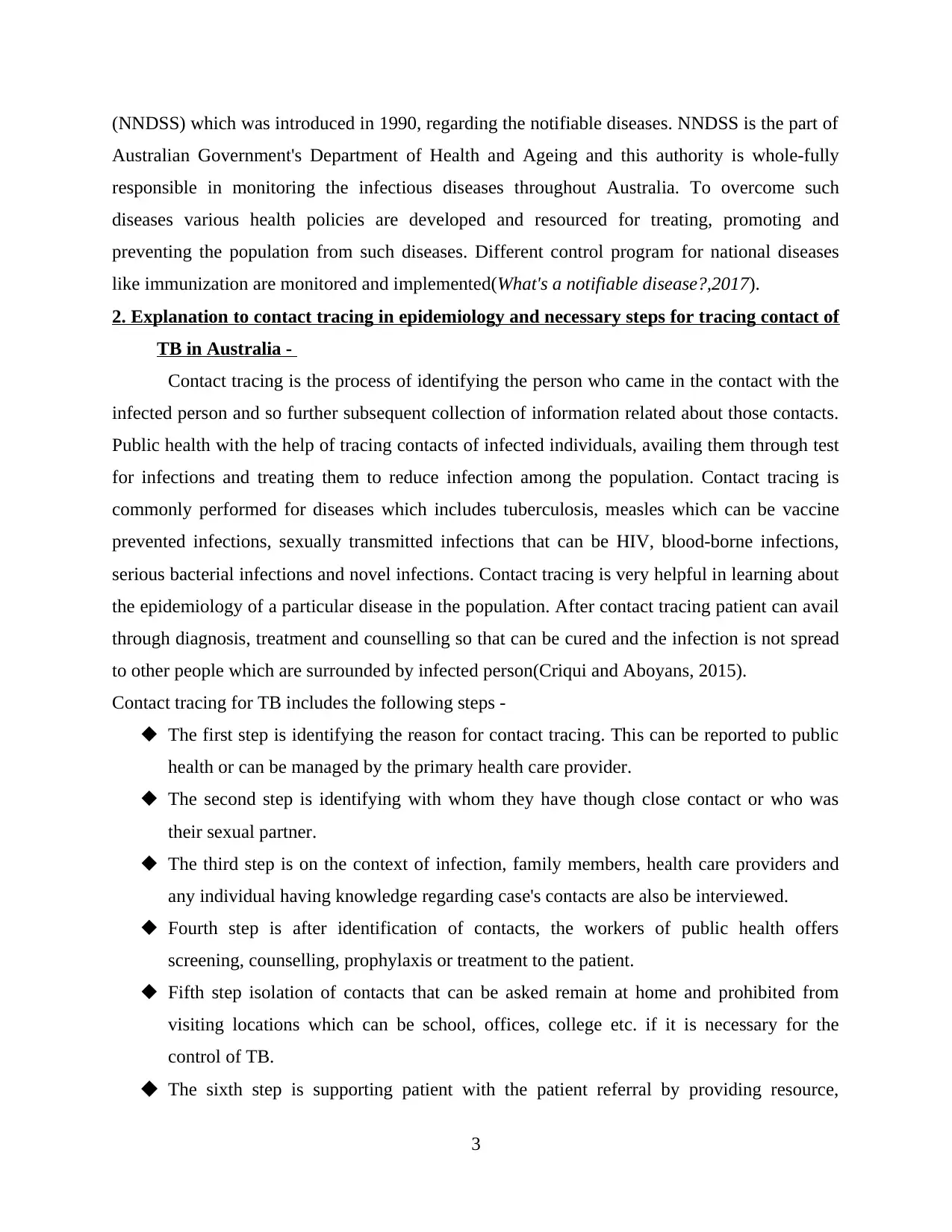
(NNDSS) which was introduced in 1990, regarding the notifiable diseases. NNDSS is the part of
Australian Government's Department of Health and Ageing and this authority is whole-fully
responsible in monitoring the infectious diseases throughout Australia. To overcome such
diseases various health policies are developed and resourced for treating, promoting and
preventing the population from such diseases. Different control program for national diseases
like immunization are monitored and implemented(What's a notifiable disease?,2017).
2. Explanation to contact tracing in epidemiology and necessary steps for tracing contact of
TB in Australia -
Contact tracing is the process of identifying the person who came in the contact with the
infected person and so further subsequent collection of information related about those contacts.
Public health with the help of tracing contacts of infected individuals, availing them through test
for infections and treating them to reduce infection among the population. Contact tracing is
commonly performed for diseases which includes tuberculosis, measles which can be vaccine
prevented infections, sexually transmitted infections that can be HIV, blood-borne infections,
serious bacterial infections and novel infections. Contact tracing is very helpful in learning about
the epidemiology of a particular disease in the population. After contact tracing patient can avail
through diagnosis, treatment and counselling so that can be cured and the infection is not spread
to other people which are surrounded by infected person(Criqui and Aboyans, 2015).
Contact tracing for TB includes the following steps -
The first step is identifying the reason for contact tracing. This can be reported to public
health or can be managed by the primary health care provider.
The second step is identifying with whom they have though close contact or who was
their sexual partner.
The third step is on the context of infection, family members, health care providers and
any individual having knowledge regarding case's contacts are also be interviewed.
Fourth step is after identification of contacts, the workers of public health offers
screening, counselling, prophylaxis or treatment to the patient.
Fifth step isolation of contacts that can be asked remain at home and prohibited from
visiting locations which can be school, offices, college etc. if it is necessary for the
control of TB.
The sixth step is supporting patient with the patient referral by providing resource,
3
Australian Government's Department of Health and Ageing and this authority is whole-fully
responsible in monitoring the infectious diseases throughout Australia. To overcome such
diseases various health policies are developed and resourced for treating, promoting and
preventing the population from such diseases. Different control program for national diseases
like immunization are monitored and implemented(What's a notifiable disease?,2017).
2. Explanation to contact tracing in epidemiology and necessary steps for tracing contact of
TB in Australia -
Contact tracing is the process of identifying the person who came in the contact with the
infected person and so further subsequent collection of information related about those contacts.
Public health with the help of tracing contacts of infected individuals, availing them through test
for infections and treating them to reduce infection among the population. Contact tracing is
commonly performed for diseases which includes tuberculosis, measles which can be vaccine
prevented infections, sexually transmitted infections that can be HIV, blood-borne infections,
serious bacterial infections and novel infections. Contact tracing is very helpful in learning about
the epidemiology of a particular disease in the population. After contact tracing patient can avail
through diagnosis, treatment and counselling so that can be cured and the infection is not spread
to other people which are surrounded by infected person(Criqui and Aboyans, 2015).
Contact tracing for TB includes the following steps -
The first step is identifying the reason for contact tracing. This can be reported to public
health or can be managed by the primary health care provider.
The second step is identifying with whom they have though close contact or who was
their sexual partner.
The third step is on the context of infection, family members, health care providers and
any individual having knowledge regarding case's contacts are also be interviewed.
Fourth step is after identification of contacts, the workers of public health offers
screening, counselling, prophylaxis or treatment to the patient.
Fifth step isolation of contacts that can be asked remain at home and prohibited from
visiting locations which can be school, offices, college etc. if it is necessary for the
control of TB.
The sixth step is supporting patient with the patient referral by providing resource,
3
Secure Best Marks with AI Grader
Need help grading? Try our AI Grader for instant feedback on your assignments.

arranging follows up, medication for the patient(Robertson, 2015).
3. Identification of jurisdictional and procedural differences -
Tuberculosis Contract Tracing guidelines for Northern Territory is the written documents
which provide the complete information to the health professionals in their treatment, diagnosis
and management of tuberculosis. Different measures are also provided in these guidelines which
is putted to facilitate the various controls of tuberculosis and epidemiology background by the
NT, Centre for Disease Control. It also includes the diagnosis of TB for various age groups,
control for infections, BCG vaccine, proper treatment for tuberculosis, contact tracing and
screening in the community in the high risky areas. The primary goal of approach is to left out
victims f TB by providing them active LTBI as son as it is identified(Tong and et.al.,2015).
Steps involved in Northern Territory contact tracing are categorizing the index case
according to the level of infection. Identifying and arranging contacts on the basis of risk level
that is high, low and medium. Later examining the cases of high risk of pulmonary TB. Further
the medium risk contacts are examined is done by low-risk contacts and thus the regional TB
health care staff has to travel to the TB diagnosed community for educating friends and family.
On the other hand, Tuberculosis Contact Tracing guidelines for Victoria is based on
Institute Peter Doherty for infection and immunity. The steps involved in the Victorian
guidelines which are advised to be followed by staff is categorising the disease according to the
infectiousness that is highly infected, medium infected and low infected. The sputum smear
positive for high infection is positive and for medium infection it is negative and low infection
also sated negative. For identifying priority groups the infection period must be identified.
Whereas, overall infectious period is 3 months with prior to TB diagnosis. The last step is
assigning the priorities on screening based on high, medium and low risk groups(Bhopal, 2016).
4. Report -
4.1 Signs and symptoms of tuberculosis and disease burden of TB -
The bacteria of tuberculosis may harbor the body of patient but immune system prevent
them from becoming sick so the doctors distinguish between Latent TB and Active TB. Where
Latent TB is the condition where the patient has Tb infection in the body but bacteria remain
inactive and no symptoms are caused. In Active TB the patient becomes sick and in most cases
the disease can be spread to others. The signs and symptoms for active TB are as follows -
4
3. Identification of jurisdictional and procedural differences -
Tuberculosis Contract Tracing guidelines for Northern Territory is the written documents
which provide the complete information to the health professionals in their treatment, diagnosis
and management of tuberculosis. Different measures are also provided in these guidelines which
is putted to facilitate the various controls of tuberculosis and epidemiology background by the
NT, Centre for Disease Control. It also includes the diagnosis of TB for various age groups,
control for infections, BCG vaccine, proper treatment for tuberculosis, contact tracing and
screening in the community in the high risky areas. The primary goal of approach is to left out
victims f TB by providing them active LTBI as son as it is identified(Tong and et.al.,2015).
Steps involved in Northern Territory contact tracing are categorizing the index case
according to the level of infection. Identifying and arranging contacts on the basis of risk level
that is high, low and medium. Later examining the cases of high risk of pulmonary TB. Further
the medium risk contacts are examined is done by low-risk contacts and thus the regional TB
health care staff has to travel to the TB diagnosed community for educating friends and family.
On the other hand, Tuberculosis Contact Tracing guidelines for Victoria is based on
Institute Peter Doherty for infection and immunity. The steps involved in the Victorian
guidelines which are advised to be followed by staff is categorising the disease according to the
infectiousness that is highly infected, medium infected and low infected. The sputum smear
positive for high infection is positive and for medium infection it is negative and low infection
also sated negative. For identifying priority groups the infection period must be identified.
Whereas, overall infectious period is 3 months with prior to TB diagnosis. The last step is
assigning the priorities on screening based on high, medium and low risk groups(Bhopal, 2016).
4. Report -
4.1 Signs and symptoms of tuberculosis and disease burden of TB -
The bacteria of tuberculosis may harbor the body of patient but immune system prevent
them from becoming sick so the doctors distinguish between Latent TB and Active TB. Where
Latent TB is the condition where the patient has Tb infection in the body but bacteria remain
inactive and no symptoms are caused. In Active TB the patient becomes sick and in most cases
the disease can be spread to others. The signs and symptoms for active TB are as follows -
4

Coughing from continuous three weeks or more.
Coughing including the blood outflow.
Pain in the chest, or pain while breathing or coughing.
Eventually weight loss.
Some common symptoms that can be fever, feeling cold and chill, sweating at night,
fatigue and loss of appetite etc (Hruby and Hu, 2015).
Tuberculosis can also affect to the other body parts which can include kidneys, brain or spine. If
TB occurs outside lungs then symptoms and signs may vary according to the organs.
Tuberculosis death rate in Australia reported in 2016 is 0.2 per 100,000 people, according
to World Bank collection of development indicators, gathered from recognized official sources.
The mortality rate due to TB by 42 percent. Prevalence rate in Australia due to TB per year are
reported approximately 1300 cases. Tuberculosis case notification rate is 5.5 cases per
population of 100,000 population. Australia has a low Tuberculosis incidence country as
compare to other countries. In year 2016 it was notified with 5.7 cases per 100,000 population in
the country(Merrill, 2019).
4.2 Transmission of pulmonary Tuberculosis and their associated infections -
Some people develop pulmonary tuberculosis soon after getting infected within the
weeks until their immune system can fight with such bacteria. Other people may get ill years
later, when their immune system becomes weak due to another reason. About 5 to 10% of
infected individuals who do not take treatment for latent TB infection will adopt the TB disease
at some time in their life cycle. Person who has a weak immune system, especially the individual
who is suffering form HIV infection then risk of developing pulmonary disease is very high as
compare to normal immune system. It is caused by the bacteria called Mycobacterium
tuberculosis. It is usually spread from person to person by in-taking the infected air during close
contact with pulmonary infected individual(Settipane and Charnock, 2016).
Risk factors of Pulmonary Tuberculosis -
Friends and family of infected person with TB disease.
People from the various parts of world having high rate of pulmonary TB which includes
India and some parts of Africa & Asia.
Group of people including homeless individuals, regular user of injection drugs and
5
Coughing including the blood outflow.
Pain in the chest, or pain while breathing or coughing.
Eventually weight loss.
Some common symptoms that can be fever, feeling cold and chill, sweating at night,
fatigue and loss of appetite etc (Hruby and Hu, 2015).
Tuberculosis can also affect to the other body parts which can include kidneys, brain or spine. If
TB occurs outside lungs then symptoms and signs may vary according to the organs.
Tuberculosis death rate in Australia reported in 2016 is 0.2 per 100,000 people, according
to World Bank collection of development indicators, gathered from recognized official sources.
The mortality rate due to TB by 42 percent. Prevalence rate in Australia due to TB per year are
reported approximately 1300 cases. Tuberculosis case notification rate is 5.5 cases per
population of 100,000 population. Australia has a low Tuberculosis incidence country as
compare to other countries. In year 2016 it was notified with 5.7 cases per 100,000 population in
the country(Merrill, 2019).
4.2 Transmission of pulmonary Tuberculosis and their associated infections -
Some people develop pulmonary tuberculosis soon after getting infected within the
weeks until their immune system can fight with such bacteria. Other people may get ill years
later, when their immune system becomes weak due to another reason. About 5 to 10% of
infected individuals who do not take treatment for latent TB infection will adopt the TB disease
at some time in their life cycle. Person who has a weak immune system, especially the individual
who is suffering form HIV infection then risk of developing pulmonary disease is very high as
compare to normal immune system. It is caused by the bacteria called Mycobacterium
tuberculosis. It is usually spread from person to person by in-taking the infected air during close
contact with pulmonary infected individual(Settipane and Charnock, 2016).
Risk factors of Pulmonary Tuberculosis -
Friends and family of infected person with TB disease.
People from the various parts of world having high rate of pulmonary TB which includes
India and some parts of Africa & Asia.
Group of people including homeless individuals, regular user of injection drugs and
5

people residing with the HIV infected people have high rates of TB transmission.
People working or residing in the institutions or facilities that house people are at high
risk for TB that can be homeless shelters, hospitals, correctional facilities, residential
homes and nursing homes for those with HIV.
Not everyone is infected with TB germs people with weak immune system may also
develop the TB bacteria that can be babies & young children's, people with kidney
disease or diabetes, people having HIV/AIDS etc.
This disease is highly communicable and can spread easily to other particularly to the person
with weak immune system(Machin and et.al.,2018).
4.3 High risk groups and clinical circumstances -
The high risk group in the report are the family of the infected student and the patients
and staff who are present in the clinic where the student is getting medication. The brother, sister
can also be infected by the germs present in the body of that student by the air. Neighbourhood
can also be affected by such bacteria as the air they are breathing somehow infected by that
infected student thus the TB bacteria can be carried forward to their body when they intake such
infected air.
If those risk groups somehow finds the symptoms of the TB in them then they should
suddenly refer the doctor for the clinical blood test and relevant tests so that they can be cured by
the disease at the latent TB stage so that these bacteria couldn't be converted into the active TB.
The family members should be more conscious about such symptoms as the large number of
bacteria are presented in their house only and can go into their body through many ways(Costello
and Angold, 2016).
4.4 Process for identified household contacts along with follow-ups -
Process of identified household contacts includes the interview of the index case as soon as
possible after the process of diagnosis to identify contacts. First priority of interviewed question
focus on household, but questions should also cover other environments. The home visit should
be done of the student for the clear understanding of the patient circumstances. Further all
identified prioritized contacts of index case are guided to visit health facility for evaluation(Peto,
2016). The result of their assessment should be further recorded. The process of screening TB
contacts must be clearly identified. Limited evaluation is conducted for testing whether the
contact has such symptoms of TB or not. All adults and adolescent TB contact must be asked if
6
People working or residing in the institutions or facilities that house people are at high
risk for TB that can be homeless shelters, hospitals, correctional facilities, residential
homes and nursing homes for those with HIV.
Not everyone is infected with TB germs people with weak immune system may also
develop the TB bacteria that can be babies & young children's, people with kidney
disease or diabetes, people having HIV/AIDS etc.
This disease is highly communicable and can spread easily to other particularly to the person
with weak immune system(Machin and et.al.,2018).
4.3 High risk groups and clinical circumstances -
The high risk group in the report are the family of the infected student and the patients
and staff who are present in the clinic where the student is getting medication. The brother, sister
can also be infected by the germs present in the body of that student by the air. Neighbourhood
can also be affected by such bacteria as the air they are breathing somehow infected by that
infected student thus the TB bacteria can be carried forward to their body when they intake such
infected air.
If those risk groups somehow finds the symptoms of the TB in them then they should
suddenly refer the doctor for the clinical blood test and relevant tests so that they can be cured by
the disease at the latent TB stage so that these bacteria couldn't be converted into the active TB.
The family members should be more conscious about such symptoms as the large number of
bacteria are presented in their house only and can go into their body through many ways(Costello
and Angold, 2016).
4.4 Process for identified household contacts along with follow-ups -
Process of identified household contacts includes the interview of the index case as soon as
possible after the process of diagnosis to identify contacts. First priority of interviewed question
focus on household, but questions should also cover other environments. The home visit should
be done of the student for the clear understanding of the patient circumstances. Further all
identified prioritized contacts of index case are guided to visit health facility for evaluation(Peto,
2016). The result of their assessment should be further recorded. The process of screening TB
contacts must be clearly identified. Limited evaluation is conducted for testing whether the
contact has such symptoms of TB or not. All adults and adolescent TB contact must be asked if
6
Paraphrase This Document
Need a fresh take? Get an instant paraphrase of this document with our AI Paraphraser

they would be suffering from cough more than two weeks. If they are suffering from persistent
cough then Sputum smear examinations must be taken out. All PLHIV and children's must be
thoroughly assessed for the TB, this may also include extrapulmonary sites.
Follow-ups -
The student receiving isoniazid preventive therapy (IPT) should be examined within the
regular intervals at the early stage of treatment to determine it does not have any adverse effect
of therapy and encouraging adherence. After the completion of treatment, student must be asked
to take care if cough or any other TB symptoms that could develop later in the lives. Further
follow-up are not required. If persistent cough and any symptoms occurs within a few months or
week the student guided to visit the health facility so that it could be cured early(Giesecke,
2017).
4.5 Time duration of diagnosis and concerned by the parents and teacher for the further
development of TB -
Student (index case) will be able to attend the classes within the 6 months. It also
depends on the immune system and spread of the disease whether the TB bacteria present is
active or latent in the body of the index case. Thus, it should also be recommended that the
treatment which is given to student is appropriate or not. And how soon the body accepts the
treatment.
Yes the parents and teachers should be concerned about the development of TB in that
student. They must take care if that student was suffering from consistent coughing and any other
symptoms of TB. They should take that index case to the medical facilities so that student can be
cured before again he gets through the active pulmonary TB. The student can again get through
such symptoms within the weeks or month so the parents and teacher of that student must be
aware regrading the health of that student. As the student may again get through the smear
positive pulmonary TB by respiring infected air. As the student now doesn't have such a strong
immune system which can fight through such bacteria and safeguards themselves form
developing such bacteria in the body(Oakes and Kaufman, 2017).
CONCLUSION
From the above study it is concluded that the notifiable disease that is tuberculosis is
7
cough then Sputum smear examinations must be taken out. All PLHIV and children's must be
thoroughly assessed for the TB, this may also include extrapulmonary sites.
Follow-ups -
The student receiving isoniazid preventive therapy (IPT) should be examined within the
regular intervals at the early stage of treatment to determine it does not have any adverse effect
of therapy and encouraging adherence. After the completion of treatment, student must be asked
to take care if cough or any other TB symptoms that could develop later in the lives. Further
follow-up are not required. If persistent cough and any symptoms occurs within a few months or
week the student guided to visit the health facility so that it could be cured early(Giesecke,
2017).
4.5 Time duration of diagnosis and concerned by the parents and teacher for the further
development of TB -
Student (index case) will be able to attend the classes within the 6 months. It also
depends on the immune system and spread of the disease whether the TB bacteria present is
active or latent in the body of the index case. Thus, it should also be recommended that the
treatment which is given to student is appropriate or not. And how soon the body accepts the
treatment.
Yes the parents and teachers should be concerned about the development of TB in that
student. They must take care if that student was suffering from consistent coughing and any other
symptoms of TB. They should take that index case to the medical facilities so that student can be
cured before again he gets through the active pulmonary TB. The student can again get through
such symptoms within the weeks or month so the parents and teacher of that student must be
aware regrading the health of that student. As the student may again get through the smear
positive pulmonary TB by respiring infected air. As the student now doesn't have such a strong
immune system which can fight through such bacteria and safeguards themselves form
developing such bacteria in the body(Oakes and Kaufman, 2017).
CONCLUSION
From the above study it is concluded that the notifiable disease that is tuberculosis is
7
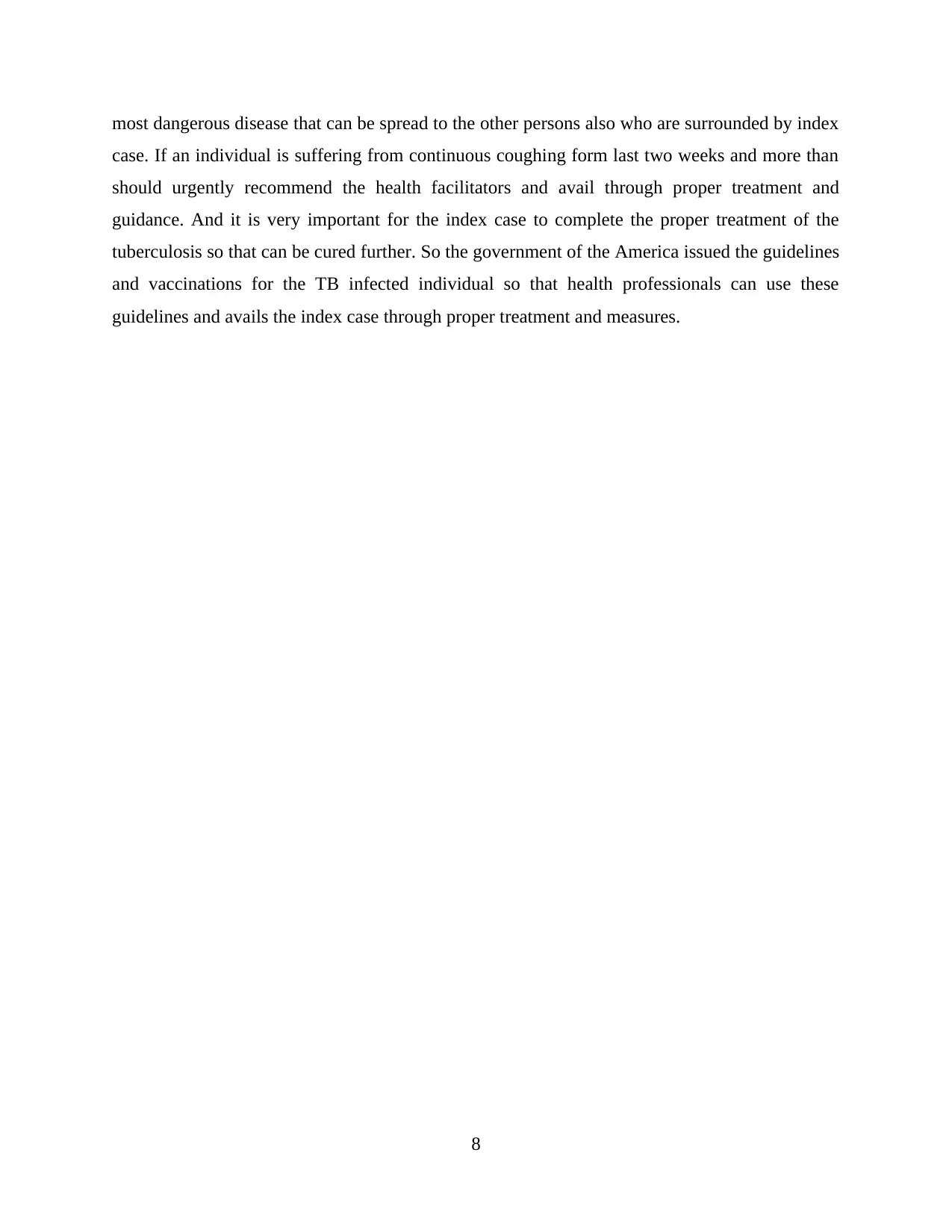
most dangerous disease that can be spread to the other persons also who are surrounded by index
case. If an individual is suffering from continuous coughing form last two weeks and more than
should urgently recommend the health facilitators and avail through proper treatment and
guidance. And it is very important for the index case to complete the proper treatment of the
tuberculosis so that can be cured further. So the government of the America issued the guidelines
and vaccinations for the TB infected individual so that health professionals can use these
guidelines and avails the index case through proper treatment and measures.
8
case. If an individual is suffering from continuous coughing form last two weeks and more than
should urgently recommend the health facilitators and avail through proper treatment and
guidance. And it is very important for the index case to complete the proper treatment of the
tuberculosis so that can be cured further. So the government of the America issued the guidelines
and vaccinations for the TB infected individual so that health professionals can use these
guidelines and avails the index case through proper treatment and measures.
8
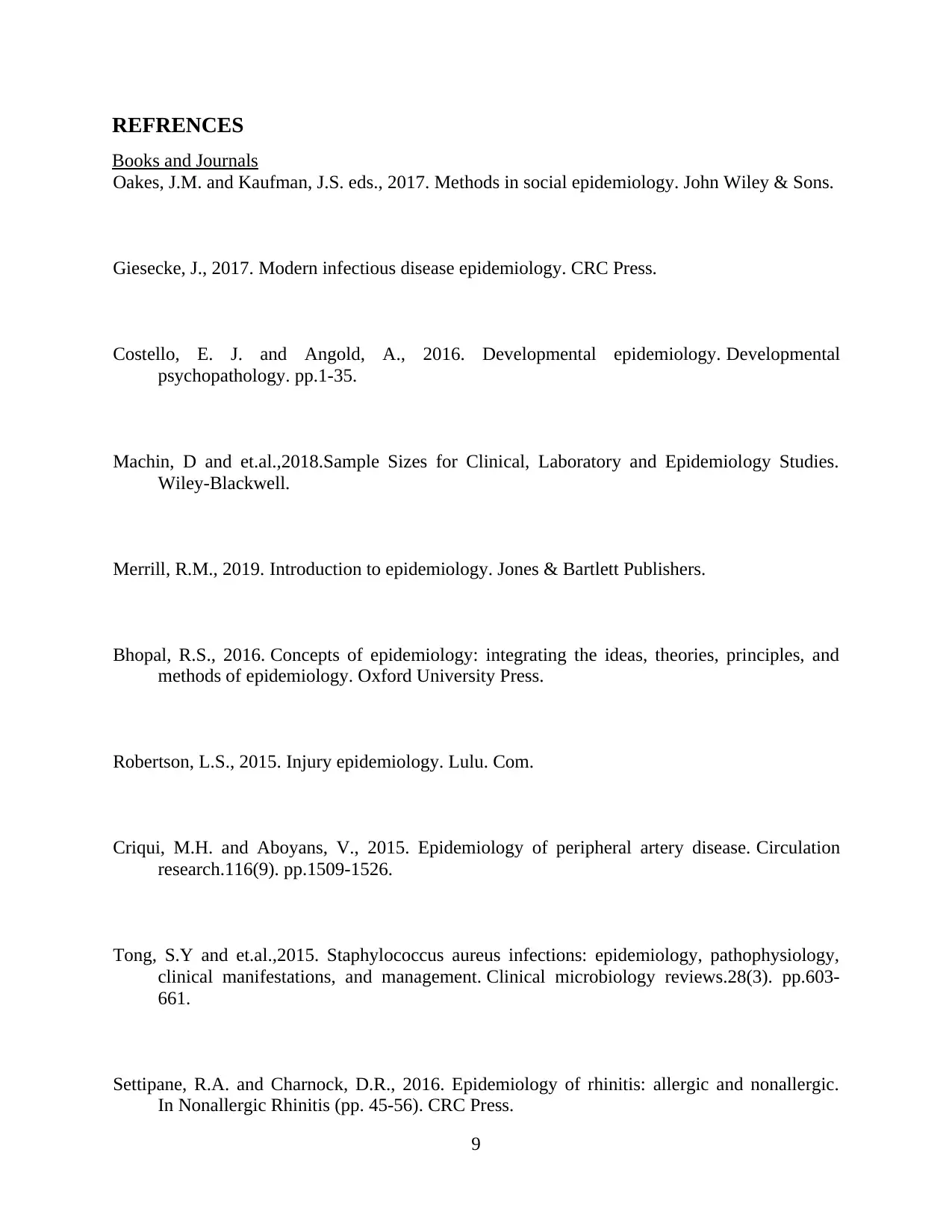
REFRENCES
Books and Journals
Oakes, J.M. and Kaufman, J.S. eds., 2017. Methods in social epidemiology. John Wiley & Sons.
Giesecke, J., 2017. Modern infectious disease epidemiology. CRC Press.
Costello, E. J. and Angold, A., 2016. Developmental epidemiology. Developmental
psychopathology. pp.1-35.
Machin, D and et.al.,2018.Sample Sizes for Clinical, Laboratory and Epidemiology Studies.
Wiley-Blackwell.
Merrill, R.M., 2019. Introduction to epidemiology. Jones & Bartlett Publishers.
Bhopal, R.S., 2016. Concepts of epidemiology: integrating the ideas, theories, principles, and
methods of epidemiology. Oxford University Press.
Robertson, L.S., 2015. Injury epidemiology. Lulu. Com.
Criqui, M.H. and Aboyans, V., 2015. Epidemiology of peripheral artery disease. Circulation
research.116(9). pp.1509-1526.
Tong, S.Y and et.al.,2015. Staphylococcus aureus infections: epidemiology, pathophysiology,
clinical manifestations, and management. Clinical microbiology reviews.28(3). pp.603-
661.
Settipane, R.A. and Charnock, D.R., 2016. Epidemiology of rhinitis: allergic and nonallergic.
In Nonallergic Rhinitis (pp. 45-56). CRC Press.
9
Books and Journals
Oakes, J.M. and Kaufman, J.S. eds., 2017. Methods in social epidemiology. John Wiley & Sons.
Giesecke, J., 2017. Modern infectious disease epidemiology. CRC Press.
Costello, E. J. and Angold, A., 2016. Developmental epidemiology. Developmental
psychopathology. pp.1-35.
Machin, D and et.al.,2018.Sample Sizes for Clinical, Laboratory and Epidemiology Studies.
Wiley-Blackwell.
Merrill, R.M., 2019. Introduction to epidemiology. Jones & Bartlett Publishers.
Bhopal, R.S., 2016. Concepts of epidemiology: integrating the ideas, theories, principles, and
methods of epidemiology. Oxford University Press.
Robertson, L.S., 2015. Injury epidemiology. Lulu. Com.
Criqui, M.H. and Aboyans, V., 2015. Epidemiology of peripheral artery disease. Circulation
research.116(9). pp.1509-1526.
Tong, S.Y and et.al.,2015. Staphylococcus aureus infections: epidemiology, pathophysiology,
clinical manifestations, and management. Clinical microbiology reviews.28(3). pp.603-
661.
Settipane, R.A. and Charnock, D.R., 2016. Epidemiology of rhinitis: allergic and nonallergic.
In Nonallergic Rhinitis (pp. 45-56). CRC Press.
9
Secure Best Marks with AI Grader
Need help grading? Try our AI Grader for instant feedback on your assignments.
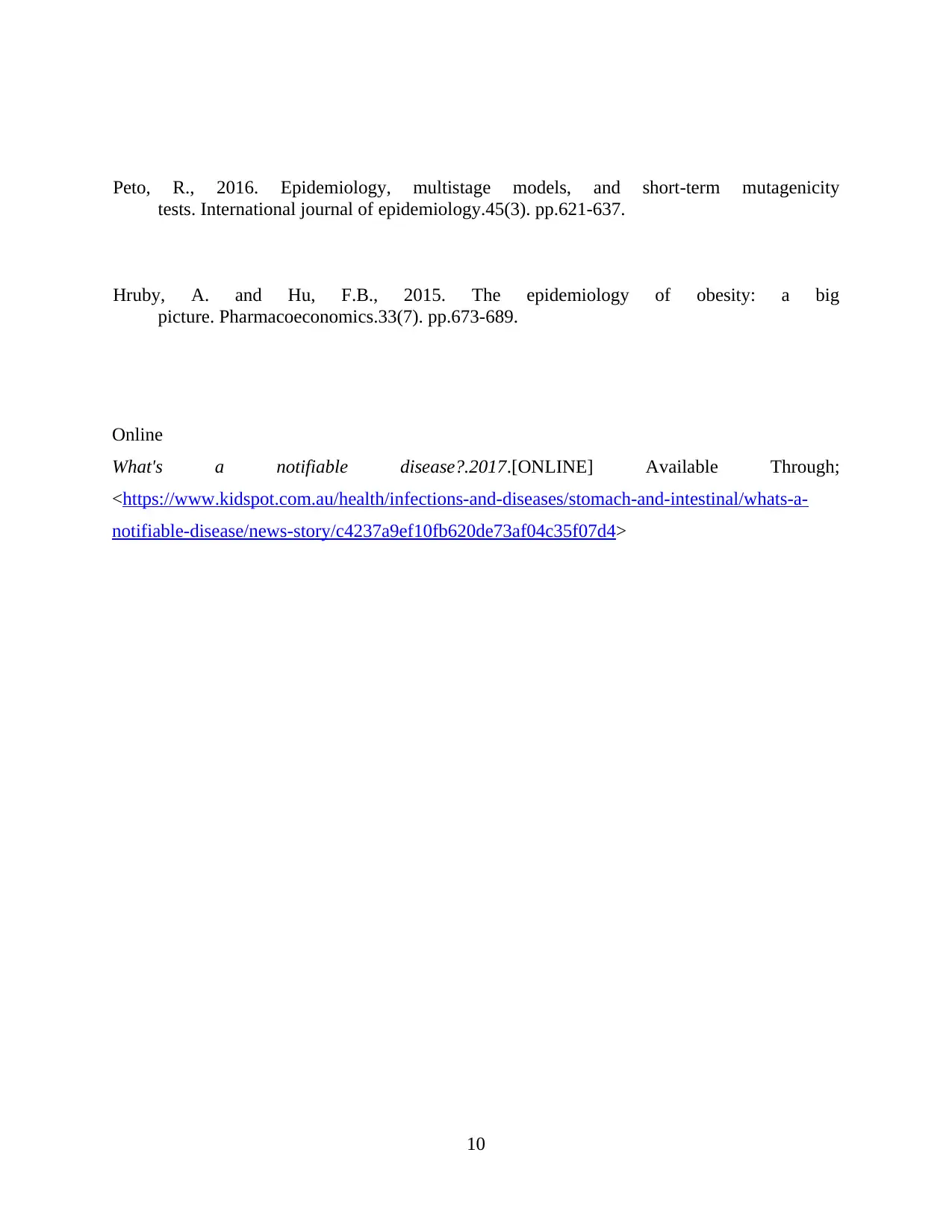
Peto, R., 2016. Epidemiology, multistage models, and short-term mutagenicity
tests. International journal of epidemiology.45(3). pp.621-637.
Hruby, A. and Hu, F.B., 2015. The epidemiology of obesity: a big
picture. Pharmacoeconomics.33(7). pp.673-689.
Online
What's a notifiable disease?.2017.[ONLINE] Available Through;
<https://www.kidspot.com.au/health/infections-and-diseases/stomach-and-intestinal/whats-a-
notifiable-disease/news-story/c4237a9ef10fb620de73af04c35f07d4>
10
tests. International journal of epidemiology.45(3). pp.621-637.
Hruby, A. and Hu, F.B., 2015. The epidemiology of obesity: a big
picture. Pharmacoeconomics.33(7). pp.673-689.
Online
What's a notifiable disease?.2017.[ONLINE] Available Through;
<https://www.kidspot.com.au/health/infections-and-diseases/stomach-and-intestinal/whats-a-
notifiable-disease/news-story/c4237a9ef10fb620de73af04c35f07d4>
10
1 out of 11
Related Documents
Your All-in-One AI-Powered Toolkit for Academic Success.
+13062052269
info@desklib.com
Available 24*7 on WhatsApp / Email
![[object Object]](/_next/static/media/star-bottom.7253800d.svg)
Unlock your academic potential
© 2024 | Zucol Services PVT LTD | All rights reserved.





